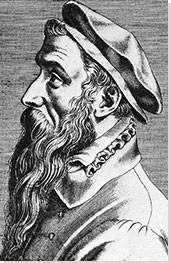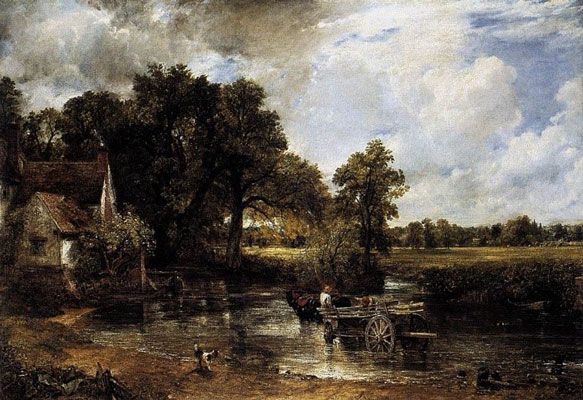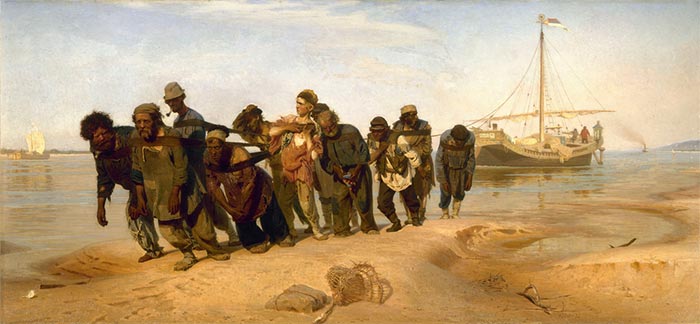Summary of Pieter Bruegel the Elder
Pieter Bruegel the Elder was an artist of the Northern Renaissance whose visually engrossing paintings offer a celebration of the common mass of humanity, in contrast to the pious religious painting which dominated much Renaissance art of the previous century. Born in what is now the Netherlands in the 1520s, reputedly into a peasant family, his work focuses on themes such as rural working life, religion and superstition, and the political and social intrigues of his day. These themes were tackled with an unmistakable, droll and often grotesque humor, an interest in the collective over the individual, and a healthy skepticism for narratives of great deeds and men. From the Dutch Golden Age painters of the following century to the Realists of nineteenth-century France and beyond, any artist who has cast their eye over their subject with an honesty debunking mythology works in the spirit of the man sometimes known as "Peasant Bruegel".
Accomplishments
- Bruegel's most distinctive stylistic contribution to art history was a form of narrative composition in which a sprawling landscape is filled with a teeming mass of humanity, figures grouped together across the canvas to form various intersecting focal points. Reminiscent of his older countryman Hieronymus Bosch's surreal hellscapes, this approach set Bruegel apart from many Renaissance artists who favored more visually harmonious compositions, offering a snapshot of a lingering medieval view of human society as chaotic and unruly.
- In accordance with his preference for large group compositions, Bruegel produced a series of mythological or historical paintings in which attention is drawn away from the nominal subject of the work towards the everyday life continuing all around it. In his Landscape with the Fall of Icarus, only a desultory pair of legs sinking into the water in the middle distance records the tragic hero's downfall. This represents a departure from the focus on heroic individuals common in Renaissance art, and suggests a sympathy with the common lot of humanity which has been recognized by artists and writers ever since.
- Bruegel was also a pioneer of what would become known as "genre painting", scenes of everyday working life captured with honesty, empathy, and occasional bathetic humor. While he is loath to pay homage to Biblical and mythical heroes, he has far less compunction about representing peasant revelers at a wedding, for example, or a procession of blind beggars. In the centuries to come, notably through the work of Dutch artists of the following century, this focus on everyday life would become the basis of the artistic ethos known as Realism.
Important Art by Pieter Bruegel the Elder
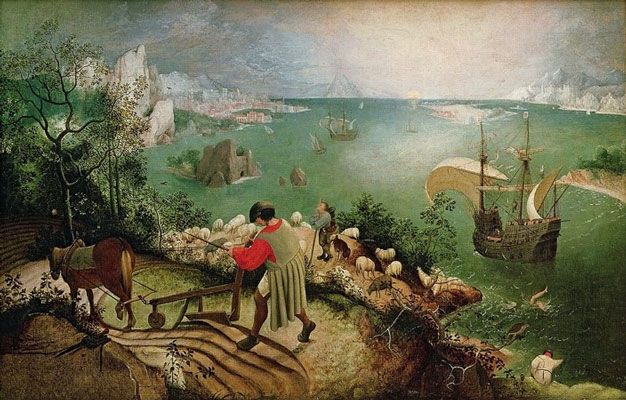
Landscape with the Fall of Icarus
One of Bruegel's best-known paintings, Landscape with the Fall of Icarus incorporates a landscape in the foreground with an expansive seascape stretching away towards the horizon. Closest to us, a farmer pushes a plow and horse. To his right, on a lower plateau of land, a shepherd tends to his flock. In the right foreground, a fisherman with his back to the viewer casts his net at the water's edge, while close to the shore in the bottom-right, two legs kick in the air: a comically minute reference to the titular narrative, which therefore seems to unfold in the background of the scene.
This is one of two paintings by Bruegel, which depict the story of Icarus as told in Ovid's Metamorphoses. These were the only two works which Bruegel created on mythological themes, in marked contrast to his contemporaries' focus on heroic narratives. The story revolves around the death of Icarus, the boy who wanted so badly to fly that he constructed wings out of wax and feathers. Failing to heed his father's warning not to fly too close to the sun, his wings melted and he plunged into the sea. We might expect that this tragic denouement would form the focal point of Bruegel's painting, but instead it becomes one incident woven into an all-encompassing representation of common rural life, the demise of the hero rendered almost laughable in its head-first ignominy. The composition is both irreverent and subtly philosophically resonant, expressing a clear skepticism for the bombastic mythological painting that had dominated the previous century of Renaissance art.
This work has been the subject of much moral speculation, revolving especially around the various figures who remain ignorant of Icarus's plight, only the shepherd glancing up towards the sky, and not even towards the relevant spot. The displacement of Icarus from center-stage has been interpreted as a directive to remain focused on one's own daily life. William Dello Russo has even suggested that the painting may illustrate a well-known Netherlandish expression, "one does not stay the plow for one who is dying." Landscape with the Fall of Icarus was given its most famous twentieth-century treatment by the poet W.H. Auden, whose poem Musée des Beaux Arts (1938) considers how suffering and personal drama take place in a wider context of ongoing life.
Oil on canvas - Musées Royaux des Beaux-Arts, Brussels, Belgium
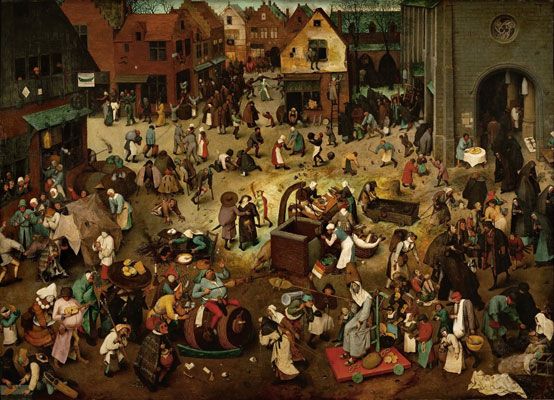
The Fight between Carnival and Lent
In one of his more lurid and chaotic paintings, Bruegel offers us a dense allegorical representation of the competing drives underpinning human character by showing the customs associated with two festivals closely aligned in the early-modern calendar. To the left, the figure of the Carnival holds sway: a fat man astride a beer barrel with a pork chop pinned to its front, spit-roasting a pig and wearing a meat pie as a helmet. He presides over a scene populated by jesters, revelers, musicians, thieves, and beggars. To the right, the gaunt figure of Lent, in the habit of a nun, extends a platter of fish, in defiance of his richer offerings. Behind her, hooded figures emerge from the archway of a church, in which the artworks are shrouded in the custom of the season of abstinence. To the other side of the canvas, the tavern provides an equivalent backdrop, standing for the sins and pleasures of the flesh.
Bruegel's complex symbolic representation of contrasting states of sin and piety, pleasure and pain, judgement and redemption, finds its most obvious precedent in the work of an older Netherlandish master, Hieronymus Bosch. In his proto-Surrealist triptych The Garden of Earthly Delights (c.1495-1505) Bosch offers a sequence of landscapes populated by figures in relative states of grace and perdition. What is notable, however, is the lack of any implied supernatural subtext to Bruegel's scene: where Bosch shows us the dire consequences of human error, Bruegel presents the spirit of the Carnival as a force of rebellion and subversion without seemingly offering any positive judgement either way.
The battle between Carnival and Lent stood partly for a contemporary struggle unfolding in Bruegel's home country. In 1556 the Low Countries, in possession of the vastly powerful Habpburg dynasty, passed to King Philip II of Spain, who sought to bring it under a more direct and stricter form of Catholic rule. At the same time, the Netherlandish countries were close to the heart of the unfolding Reformation movement, which viewed Catholic festivities such as Lent with profound suspicion. The carnivalesque energy of the left-hand side of the painting stands not so much for the emergent spirit of Protestantism - which tended to be more repressive of the traditional festive calendar than Catholicism - but for the obdurate pagan customs and rebellious character of an oppressed culture.
Oil on panel - Kunsthistorisches Museum, Vienna
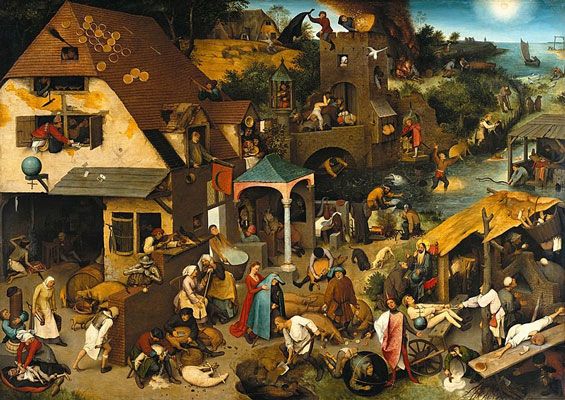
The Netherlandish Proverbs
This painting shows Bruegel's mastery of complex composition, often based on strong diagonal lines bringing overall cohesion to a large number of intersecting focal points. In The Netherlandish Proverbs, a village setting is chosen as the location for a variety of eccentric and superstitious rituals.
The actions undertaken by the villagers represent approximately 120 different Netherlandish proverbs, all related to the oddities of human behavior. In the left foreground a man bangs his head against a brick wall, representing the tendency of a fool to continue attempting the impossible; to the right, a figure leans distraught over a pot of spilt porridge, reminding the viewer that completed actions cannot be undone. Bruegel is noted for his busy compositions, involving many groups of figures engaged in small interactions. These individual compositions in turn establish an overall theme, often satirical or didactic, a compositional approach which has had a profound impact on art history. The influence of Bruegel's allegorical tableaux can be sensed, for example, in the work of the Dutch Symbolist and Expressionist James Ensor, who uses a similar compositional style in Christ's Entry into Brussels (1888) and The Baths at Ostend (1890).
Bruegel's significance as a forerunner of modern art lies not only in his breaking away from the ordered vanishing-point perspectives and carefully-managed figurative arrangements of the Italian Renaissance, but also from the idealized moral style and grandiose subject-matter which those features implied. By depicting the foibles of everyday human life, Bruegel expanded the range of subjects available to the Renaissance painter with characteristic, irreverent wit.
Oil on wood - Gemäldegalerie, Berlin, Germany
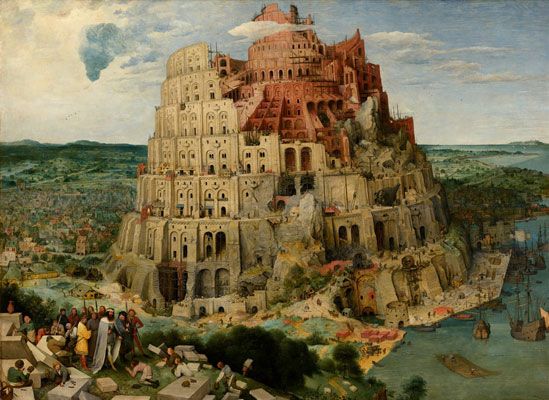
The Tower of Babel
A vast, partially constructed tower dominates Bruegel's extraordinary 1563 work The Tower of Babel. Surrounding the structure is a landscape dotted with tiny figures, some of whom march in procession around its curving stories, while others toil at the scaffolds along its sides. To the right, ships unload building materials; in every respect of detail, the painting is minutely, naturalistically accurate.
This is one of three paintings Bruegel created around the Biblical tale of the Tower of Babel. In so doing, he chose a story intended to provide a moral directive around the dangers of over-reaching ambition. In the original narrative from the Book of Genesis, God prevents King Nimrod from building a tower designed to reach to the heights of heaven, cursing the builders so that they are unable to communicate in the same language. In this painting, Nimrod is presented in the foreground discussing his project with an entourage of sycophantic courtiers, while enfeebled subjects crawl around his feet. The structure behind him is, in part, intended to be reminiscent of a Roman amphitheater, the Roman Empire being a symbol of the hubris of human ambition in Bruegel's day.
As with so much of Bruegel's work, the moral message also has a contemporary resonance. Living at a time when mainland Europe was being ravaged by rival religious factions - on the one hand, the Catholic empires of the south, on the other the dissenting Protestant cultures of the north - the story of a once morally united, monoglot religious society fracturing into rival groupings was a pertinent one; particularly as one of the founding causes of Protestantism was the translation of the Bible into modern script. Bruegel was sympathetic with the Protestant culture of his home country, and another version of the painting, The Little Tower of Babel" (c. 1568) provides a direct critique of Catholic ceremonial pomp. On one of the ramps extending up the tower, a group of figures marches under a line of red canopies, generally understood to be a veiled reference to the customs of the Catholic church, on whose behalf the Duke of Alba was brutally subduing Bruegel's homeland during the 1550s-60s.
Oil on panel - Kunsthistorisches Museum, Vienna
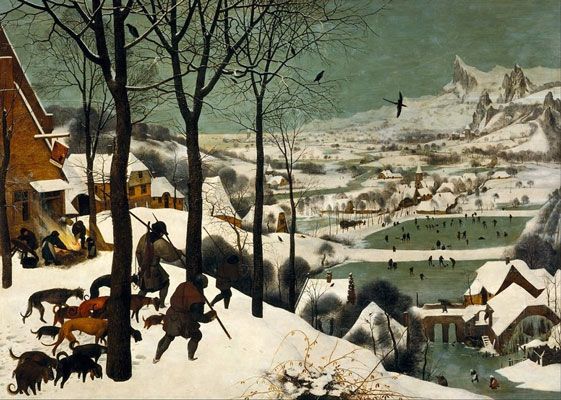
The Hunters in the Snow
In a snow-covered landscape, three hunters lead their dogs through a picturesque, sprawling village. Vivid silhouettes of winter trees dominate the left-hand side of the composition, and, along with the direction of the hunters' movement, lead the eye towards the busy scene at the center, a happy gathering of people on a frozen river. In the background, buildings and snow-covered mountains recede into the distance beneath a blue-gray winter sky.
One of a series of paintings that Bruegel created to depict different seasons of the year, this work demonstrates his unique aptitude for capturing the spirit of the natural world. William Dello Russo describes The Hunters in the Snow as "one of the best-loved works by Bruegel", and "undoubtedly the best-known image of winter in Western art [...] Never before had a painter managed to create such a convincing representation of the coldness, the silence, and the torpor of the winter landscape." Bruegel's approach moves well beyond the characteristic landscape-painting techniques of his era, offering complex compositions that rely on color harmonies to convey the mood of the scene and season. Rose-Marie and Rainer Hagen suggest that "the picture is dominated by two 'cold' colors, the white of the snow and the pale green of the sky and ice. Every living thing is dark. This stands in contradiction to the customary color associations connected with being alive, and heightens the impressions of misery and privation." However, the number of people in the painting, and their state of busy activity, suggests liveliness and collectivity in the midst of the frozen landscape, indicating a community not dominated by their surroundings but making their lives within it.
Early in his career, Bruegel drew influence from the Flemish landscape artist Joachim Patinir, who also created paintings which seem to recede telescopically away from the eye. Expanding on Patinir's style, Bruegel's focus on landscape as a self-sufficient subject-matter had a profound impact on the development of modern art, including landscape painting of the Romantic and Naturalist movements. The exaggerated perspectival style of works like Hunters in the Snow, meanwhile, prefigures all subsequent landscape painting in which the conventional, post-Renaissance three-dimensional perspective is eschewed.
Oil on wood - Kunsthistorisches Museum, Vienna, Austria
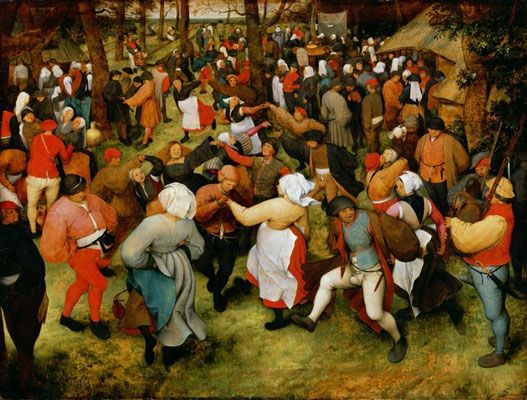
The Wedding Dance
Bruegel's life-affirming scene of peasant matrimony is crowded with happy, inebriated revelers. In the background, a table is set with food, while the wedding guests dance, drink, and kiss, forming an unruly circle which fills the central space of the composition. One figure to the right, standing in front of a tree in a black hat and orange shawl, seems detached from the scene even while integrated into the joyful spiral, his demeanor of quiet reflection leading some critics to posit that this is a self-portrait of the artist himself.
This painting is one of many created by Bruegel showing rural peasants in scenes of leisure and celebration. The prevailing thought amongst artists of the Renaissance was that only religion, mythology, and the lives of great men were fit subjects for painting. According to Rose-Marie and Rainer Hagen, "no painter before [Bruegel] had dared to produce such works. Contemporary art generally regarded peasants as figures of mockery, considering them stupid, gluttonous, drunken, and prone to violence."
Besides making these gluttonous and volatile figures worthy of artistic representation, Bruegel's decision to focus on scenes and aspects of peasant life also drew attention to the lot of the working man and woman for perhaps the first time in art history. The same motive would become more conspicuous in the work of modern artists inspired by his example, including painters of the French Realist school such as Gustave Courbet and Honoré Daumier, who used their paintings to make politically subversive statements on the living and working conditions of the poor.
Oil on wood - Institute of Arts, Detroit, Michigan
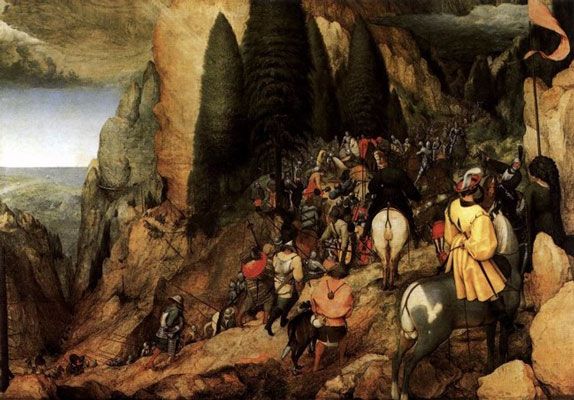
The Conversion of Paul
A mountainous forest landscape dominates Bruegel's painting The Conversion of Paul. Moving in a diagonal sweep from the center foreground to the right background, a crowd of people, including a number of soldiers in armor, swarm into a gap in the rockface. In the left background, behind the crest of the mountain, a calm body of water stretches away.
While this work is nominally focused on the Biblical story of St. Paul's conversion on the road to Damascus, Bruegel radically departed from conventional painterly approaches to religious narrative by making the landscape, and the mass of humanity populating it, the central subject of the work. One has to look closely amongst the figures traveling the mountain path to pick out the convert thrown from his horse, lying on the ground as God strikes him blind. Indeed, without the interpretive hint provided by the title, one might fail to recognize what is taking place. As with his 'Icarus' landscapes, Bruegel detracts further from the import of the central narrative by setting the scene in a contemporary context, using the landscape of his home country as a backdrop, suggesting an irreverent, appropriative attitude to his source-material.
This painting also makes a subtle political statement. Amongst all the figures represented, the viewer's eye is drawn to a man dressed in black riding a white horse with his back to the viewer. Many believe this figure to be based on the Duke of Alba, responsible for the persecution of many Protestants in Brussels during Bruegel's lifetime, as part of a Spanish crusade to bring the Low Countries under stricter Catholic yoke. Rose-Marie and Rainer Hagen even suggest that the painting may be intended to invoke a similar conversion of Alba as overcame Paul, bringing an end to his murderous campaign. Whether or not this precise message can be inferred, the work certainly indicates the extent to which Bruegel was willing to use his art to reflect on the religious and political power-structures of his day.
Oil on wood - Kunsthistorisches Museum, Vienna, Austria
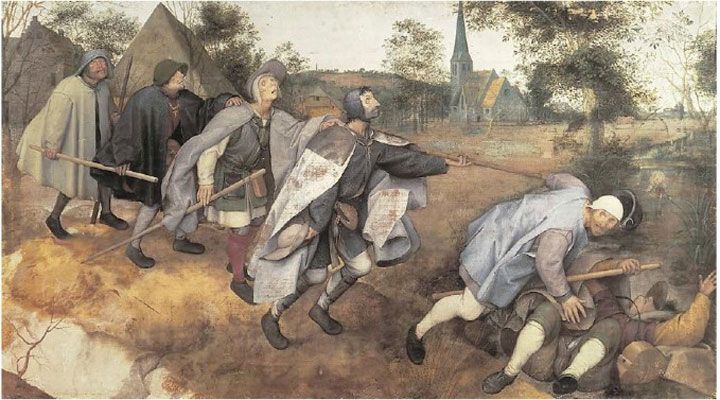
The Blind Leading the Blind
Five blind men trudge across the center of this canvas, canes in hand, arms stretched out hopelessly for guidance. The first member of the procession has already tumbled over, and lies on his back in the dirt. The man directly behind him is mid-stumble, while the steep downward curve of the path behind him suggests that the four following him will suffer the same fate. In the background, various features of a typical Bruegel landscape are visible: a church steeple, low thatched roofs, and a curving, tree-lined hillside.
Though its focus on the poor and destitute is typical of Bruegel's egalitarian concerns, this painting is marked out by its distinct compositional structure and mood. William Dello Russo has pointed out that the earthy color-palette represents a departure from Bruegel's typical tonal range - generally involving brighter colors - as does his use of tempera paint, which allows a less brash, saturated appearance than oil. As regards the visual composition, The Blind Leading the Blind is arguably a very early example of Realist genre painting, focusing closely on a small number of human figures engaged in everyday activities rather than one of the sprawling, densely populated landscapes which occupy the artist's others works.
This painting reflects Bruegel's ability to create captivating allegorical works based on both religious doctrine and common maxims. The painting illustrates a passage found in the Gospels of Matthew and Luke -"[a]nd if the blind lead the blind, both shall fall into the ditch" - but the phrase would have had the currency of a common saying, as it still does, and the curious mixture of empathy and grim amusement that the blind men's plight elicits needs no scriptural grounding. It emanates from that same elementary sense of the pathos and absurdity of human experience that the artist himself drew from. As art historian Max Dvorák wrote in 1928, "[the painting's] novelty lies in the very fact that such an insignificant occurrence with such insignificant heroes becomes the focus of this view of the world."
Tempera on canvas - Museo Nazionale di Capodimonte, Naples, Italy
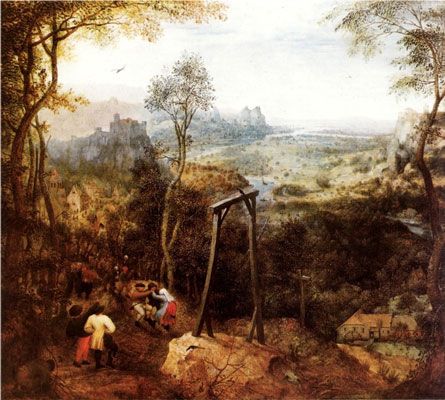
The Magpie on the Gallows
A lush woodland landscape dominates this work from the penultimate year of Bruegel's life. In the background are the gables and tiled roofs of a Netherlandish village, while in the foreground to the left, a group of young peasants plays in the fields, unmoved by the structure to their right, on which a lone magpie perches.
Bruegel was not an overtly political artist. But this work, like The Conversion of Paul, indicates his ability to offer oblique commentaries on contemporary society. The gallows would have been a recognizable symbol of oppression during the Spanish campaign in the Low Countries, with hanging a fate awaiting many religious agitators, who were often exposed by the gossip or betrayal of friends. The little bird at the center of the piece thus takes on a grim allegorical relevance via a common Netherlandish expression: "to gossip like a magpie". At the same time, the piece strikes a note of defiance, the male figure defecating in the bushes in the immediate foreground suggesting the artist's attitude towards the Spanish occupation, and calling to mind another common expression of the Low Countries, "to shit at the gallows", meaning to defy authority and death.
There is some speculation that Bruegel himself might have been a victim of malicious gossip towards the end of his life, although no specific narrative supports this theory. It is known, however, that he left this work to his wife, and Karel van Mander has argued that the gesture was a loaded one: "he was referring by the magpie to the gossips, whom he would like to see hanged."
Oil on wood - Hessisches Landesmuseum, Darmstadt, Germany
Biography of Pieter Bruegel the Elder
Childhood and Education
Though he is considered one of the greatest artists of the Northern Renaissance, little information exists about the childhood of Pieter Bruegel. All that is known for certain is that he was born Peeter Brueghel, into what many believe was a peasant family, in or near Breda in the Netherlands, between 1525 and 1530.
Early Training
Bruegel's early artistic training consisted of an apprenticeship with the Flemish artist Pieter Coecke van Aelst. After Van Aelst's death in 1550, Bruegel moved to Antwerp, where he received his first commission, to assist in the creation of a triptych altarpiece for the glove-makers guild. The guild system was important to furthering artistic careers, and Bruegel's own professional life effectively commenced in 1551 when he was elected to the Guild of St. Luke, an Antwerp painter's association.
Mature Period
In 1552, Bruegel left Antwerp for an extended painting and research trip through Italy. Although he was not heavily influenced by the Italian-Renaissance style, the countryside he visited would have a great impact on the young artist, who would become well-known for his landscape works. Of particular significance were the Swiss Alps which Bruegel ventured through on his journey home. His first biographer Karel van Mander notes that the artist "swallowed all the mountains and rocks and spat them out again as panels on which to paint, so close did he attempt to approach nature in this and other respects."
Upon returning to Antwerp in 1555, Bruegel began working as an engraver for the Dutch artist Hieronymus Cock. The engravings which Bruegel produced for his employer often involved humorous themes and motifs, leading to his being known as "Pieter the Droll". Attempting to sum up the artist's engaging personality, Van Mander described Bruegel as "a very quiet and prudent man. He was a man of few words, but he was very droll in society, and he loved to make people jump with the unexpected jests and noises that he thought up."
The complex and fantastical scenarios depicted in many of Brueghel's engravings, and in the few paintings which he created during the middle period of his career, led to comparisons with the famous Dutch painter Hieronymus Bosch (c. 1450-1516). The mercenary Cock capitalized on this reputation, selling a relatively unknown Bruegel engravings, Big Fish Eat Little Fish (1556), as a Bosch original in order to fetch a better price (Bosch had in fact died 40 years before the work was created).
Late Period
While he is best known for his paintings, Bruegel did not embrace this medium until relatively late in his career, from around 1557 onwards. It was at this point that he developed his unmistakable compositional style, allowing him to shed comparisons with older Norther Masters such as Bosch, and to secure his status as a significant and in-demand artist. Numerous commissions were forthcoming, mainly from wealthy merchants and members of the church. In 1559, the artist changed the spelling of his name from "Peeter Brueghel" to "Pieter Bruegel."
In 1563, Bruegel married Mayken Coecke, the daughter of his former teacher Pieter Coecke van Aelst. There was a significant age difference between the two, the artist in his thirties and his bride - whom he had known since she was a child - only eighteen years old. Some controversy surrounded the couple's relocation to Brussels in the year of their marriage, with speculation that it might have been at the request of Mayken's mother, in an attempt to stop Bruegel's flirtatious relationship with a maid. The extent of the relationship between artist and servant remains a mystery, though there are accounts of humorous interactions between them, such as the story that Bruegel marked a stick with a notch every time the maid told a lie. She was so deceitful, it was said, that Bruegel ran out of room on his stick.
Despite its rocky beginnings, Bruegel's marriage marked the beginning of an artistic dynasty that incorporated the couple's two artist-sons, Pieter, later known as Pieter Brueghel the Younger, born in 1564, and Jan Brueghel the Elder, born in 1568. The young Pieter would go on to create many copies of his father's paintings, helping to ensure their international reputation long after the elder Bruegel's death, but also resulting in doubt over whether particular compositions were the work of father or son.
Late in his career, in addition to his many landscape paintings, Bruegel created various works depicting religious stories and scenes from everyday life. The latter proved to be more significant and enduringly influential, generating centuries of art-historical debate around the intended message of certain works. Some of the earliest writers on Bruegel, including Van Mander, took his paintings at face-value, as humorous expositions of the lascivious behavior of the serf class. More recent interpretation, however, has emphasized Bruegel's attempts to elevate that class through celebratory representation. As the art historians Rose-Marie and Rainer Hagen put it, "the fact that he should consider such a thing at all worthy of depiction distinguishes him from almost all of his contemporaries [...] The Italians and Romanists emphasized what distinguished man from the animal and plant world. Bruegel, in contrast emphasized their similarities, the nature, 'begotten, not made' element in man." William Dello Russo expands on this idea, writing that "Bruegel's vivid and lusty depictions of rural life can be seen as forming part of a growing sense of national identity."
The fact that Bruegel lived during politically troubling times has also compounded speculation over the interpretation of his work. In the mid-1500s, the modern-day Netherlands, along with Belgium and Luxembourg - collectively known as the Low or Netherlandish Countries - consisted of a series of provinces under the rule of the Hapsburg dynasty. In 1556, possession of the territories passed to King Phillip II of Spain, who attempted to impose a stricter form of Catholic rule, sending the Duke of Alba to lead a brutal military campaign in Brussels to suppress Protestant rebellion. According to art historians Rose-Marie and Rainer Hagen, Bruegel's consistent eschewal of the iconography of Catholic saints and martyrs, in spite of the religious focus of much of his work, can be seen as a coded rejection of the philosophy and bloodthirsty campaigns of the Counter-reformation. One story which suggests that Bruegel was quite conscious of the political significance of his work is told by Van Mander: not long before the artist's death, his biographer states, Bruegel asked his wife to burn certain works, believing that their content might put her in danger.
Little is known about the circumstances of Bruegel's death, though in 1569, the final year of his life, the city council of Brussels released him from the obligation of working with a guard of Spanish soldiers stationed in his home, suggesting that the politically subversive content of his work was well understood. No paintings exist from this year, implying that Bruegel died from illness, but there is no way of ruling out a more sinister explanation. In any case, Bruegel's relatively early demise, even for the period in which he lived, must be viewed as one of the tragedies of Renaissance art history.
The Legacy of Pieter Bruegel the Elder
During his lifetime, Pieter Bruegel was seen to have made a significant break from the popular Italian Renaissance style, creating works that focused on landscape and contemporary life rather than the grand narratives favored by the Mediterranean masters of the past century. In so doing, he helped to ensure that Renaissance art in Northern Europe would unfold in its own, unique direction, contributing to a Northern Renaissance style that inspired subsequent artists such as Peter Paul Rubens and Rembrandt.
Bruegel's paintings have influenced a range of developments in modern art. The contemporary critic Wilfried Seipel writes that "[b]eyond all psychological and iconological interpretation and independent of biographical and contemporary historical preconditions, Bruegel's surviving paintings form a cycle, indeed an epic of human existence in its helplessness not only in the face of nature but also when confronted with the apparently immutable course of world history." Bruegel's decision to represent common people engaged in everyday scenes of domestic life paved the way for the Dutch Golden Age painters of the following century, and also predicted the socially-minded Realism and Naturalism of the mid-to-late nineteenth century, including the work of Gustave Courbet, Jean-François Millet, and the Russian Peredvizhniki School. During the twentieth century, poets such as W.H. Auden and William Carlos Williams were equally inspired by Bruegel's egalitarian vision, the latter dedicating a ten-poem cycle to Bruegel in his final collection, Pictures from Brueghel and Other Poems (1962).
Influences and Connections

- Pieter Coecke van Aelst
- Pieter Aertsen
- Giulio Clovio
- Hieronymus Cock
- Joachim Patinir
- Antoine Perrenot de Granvelle
- Niclaes Jonghelinck
- Abraham Ortelius
-
![Joshua Reynolds]() Joshua Reynolds
Joshua Reynolds -
![Rembrandt van Rijn]() Rembrandt van Rijn
Rembrandt van Rijn -
![Peter Paul Rubens]() Peter Paul Rubens
Peter Paul Rubens - Pieter Aertsen
- Antoine Perrenot de Granvelle
- Niclaes Jonghelinck
- Karel van Mander
- Abraham Ortelius
-
![Northern Renaissance]() Northern Renaissance
Northern Renaissance -
![Realism]() Realism
Realism -
![Social Realism]() Social Realism
Social Realism -
![Naturalism]() Naturalism
Naturalism - Landscape painting
